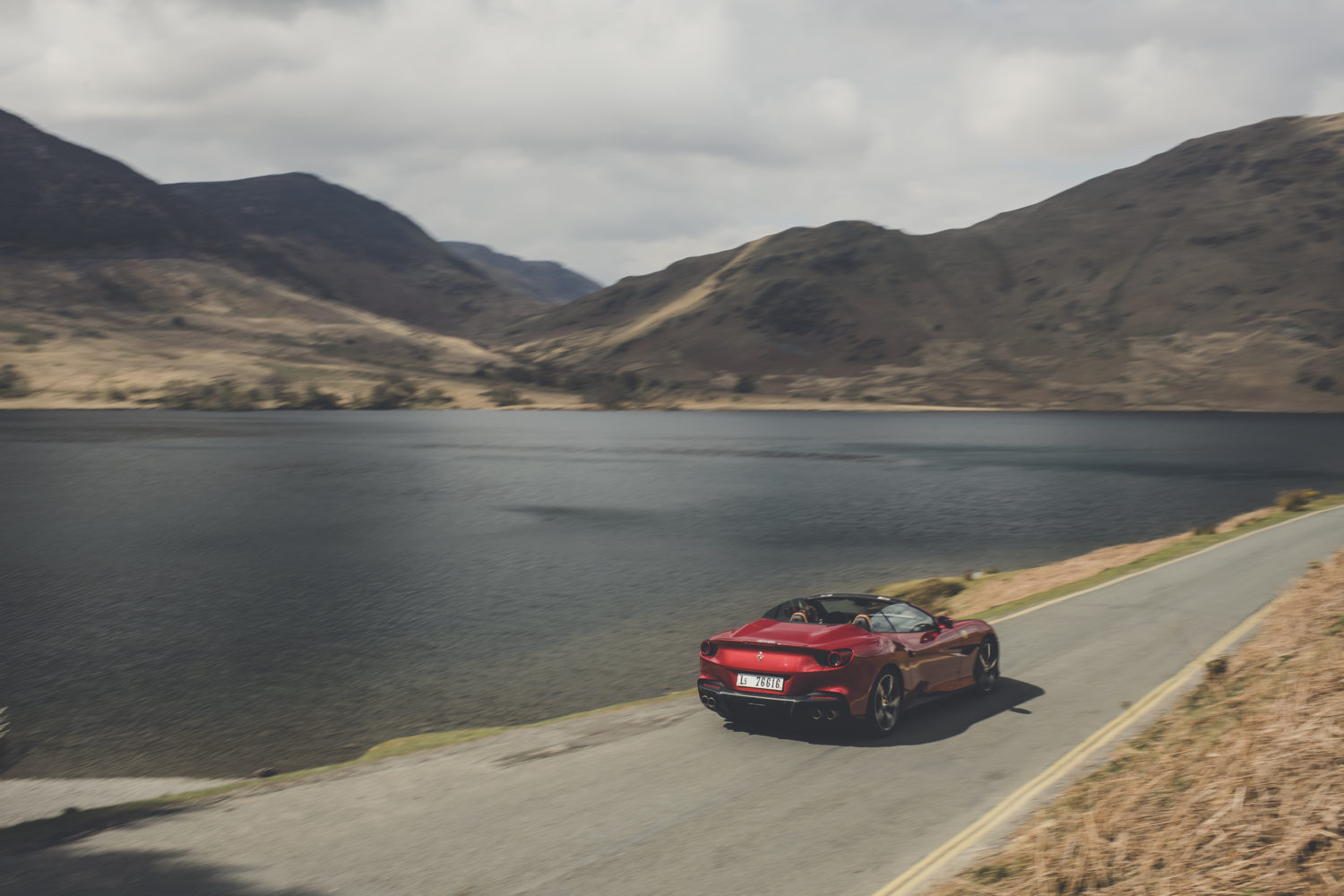
The new Ferrari Portofino M is an impeccable companion for exploring the UK and Ireland’s most spectacular roads and rediscovering the British Isles’ hidden gems.
‘M’ stands for Modificata. The updated Portofino has subtle visual changes from its predecessor (which received one of the world’s most coveted design accolades, the Red Dot: Best of the Best), to make it look even more assertive. The main changes are under its pulse-quickening skin, including more power from its 3.9-litre V8 turbo (612bhp, an increase of 20) and a new 8-speed dual-clutch gearbox. It’s also the first 2+ spider from Maranello’s stable to offer a five-position Manettino, including Race mode, making it adaptable to a more expansive range of driving conditions and missions. It promises to make the road trips documented in this compendium all the more rewarding.
So, the last year hasn’t all been bad news. And while, for now, it’s still difficult to invite you, our friends and appassionata, to visit Italy, there’s plenty of the good life to enjoy right here in the UK and Ireland until we’re able to travel further again.
Within this guide, you’ll discover our recommendations for the dozen best places to enjoy a Portofino M (or, indeed, your own wheels) throughout England, Wales, Scotland, Northern Ireland and the Republic of Ireland; roads that are exciting, scenery that is jaw-dropping, and experiences that are fun and Instagrammable. We’ve also suggested nearby destinations that, if you squint, could be in Italy, and how you can savour a taste of bella Italia courtesy of Britain’s population of Italian chefs, baristas, ice cream makers and others.
Journey well and don’t spare the prancing horses.
ENGLAND
DARTMOOR, DEVON
The painterly bleakness of Dartmoor has encouraged the growth of many legends, not least that of the Hairy Hands – disembodied hirsute mitts that suddenly grab at one’s steering wheel or handle bars and force the victim off the road. It’s a ghost story that pertains to the Postbridge stretch of the B3212,
which was purported to have seen an unusually high number of motor vehicle accidents in the early 20th century. So, you have been warned.
The B3212 might have a soulless name, but the unfenced undulating tarmac through the wilds of the moor is brimming with character. It towers and swoops over hills and down valleys, split by crystal streams and edged by treacherous bogs. More than haunting spectres, the main danger here are the sheep, and occasionally cattle, that like to sit prone in the road beyond the crests.
If arriving in Devon from the east, the B3212 starts at Exeter and runs west under the A30, reaching Dartmoor National Park at Dunsford. From there, it’s a 25-mile burn that cuts through the middle of the moor to Yelverton, which should take around 45 glorious minutes. Plymouth lies just 12 miles to the south.
The great thing about Dartmoor is it’s quiet, even in the summer, so you’re unlikely to be trapped behind traffic for long. There are 160 tors across the moor, which refer to where the granite is exposed and makes for natural landmarks for hikers. As for man-made landmarks, you may wish to stop off at Bovey Castle, a mansion built in 1907 which is now a five-star hotel and spa. Less luxurious, but even more eye-catching is the notorious Dartmoor Prison, located in Princetown. Built in 1809 to house prisoners from the Napoleonic Wars, notable former inmates include Kray acolyte Frank Mitchell, aka ‘The Mad Axeman’, who managed to escape from this nick in 1966. The prison is still taking guests and has its own museum.
Princetown is a good place to stop for refreshments, with The Plume of Feathers and the Prince of Wales (Prince Charles technically owns the prison) catering to both tourists and screws.
In addition to Bovey Castle, lunch and four-poster beds can be found along the route at the popular Two Bridges Hotel, perched on the banks of the West Dart River. For a truly stand-out gastronomic experience, though, we recommend Gidleigh Park. Located in Chagford, six miles west of Moretonhampsted, the Michelin-starred restaurant is overseen by Chris Eden. The menu changes with the seasons, but aged beef fillet cooked over coals with bone marrow is among the classics. There are 24 bedrooms to let you sleep off the weighty wine list.
Petrolheads may enjoy Moretonhampsted Motor Museum, which has over 150 vintage and classic cars and bikes, many of them pre-war. They’ve even got a Trotter brothers’ three-wheeler.
Further information: visitdartmoor.co.uk, boveycastle.com dartmoor-prison.co.uk, twobridges.co.uk, gidleigh.co.uk, moretonmotormuseum.co.uk.
SNAKE PASS, PEAK DISTRICT
The A57 that stretches across Derbyshire’s Peak District is better known by a more emotive name; the Snake Pass. The A57 starts in Sheffield, to the east, and ends in Glossop in the direction of Manchester. The Snake Pass itself runs from the Ladybower Reservoir at Ashopton, its tarmac rising through the forest and wriggling north west across the Pennines for 14 thrilling miles, plateauing at 510m above sea level.
Such is the magnificence of this road and the scenery it affords that Sheffield synth-pop icons The Human League named a tune after it. Comic character John Shuttleworth has also performed a song called ‘Incident on Snake Pass’ about a shunt he claims to have suffered in a Ford Anglia.
In fact, the moniker comes not from the sinuous ribbon of road but from a pub which used to be located close to the reservoir called The Snake Inn, which in turn took its insignia from the serpent on the Cavendish arms belonging to the sixth Duke of Devonshire. There are still many excellent pubs to be enjoyed in the area, catering for motorists, cyclists, walkers, and the local farming community. The Ladybower Inn is on Snake Pass and does food and rooms. One of the region’s most charming pubs is the Packhorse Inn in Little Longstone, which has been serving weary travellers since 1787 and is owned by local brewery Thornbridge. Try the award-winning Jaipur pale ale and the a la carte venison haunch.
The Old Hall Inn, on the District’s western edge at Chinley, has not only one of the best beer gardens but also characterful bedrooms with four-posters. Their Sunday roast is to die for. Luxury digs are available at Fischer’s Baslow Hall, to the east, a handsome manor with well-tended gardens and a Michelin-starred fine dining restaurant that attracts foodies from afar. Dishes change with the seasons, but might include pan-fried John Dory with a lemon verbena and ginger bisque.
There’s plenty to do in the area, including a visit to the stately Chatsworth House. Do explore the caves at Castleton, particularly Peak Cavern aka ‘The Devil’s Arse’, where local resident Jarvis Cocker recently recorded music. And grab a Bakewell tart from its birthplace, Bakewell. The town’s aforementioned brewery, Thornbridge, make a raspberry jam-flavoured beer in homage to the dessert.
Further information: visitpeakdistrict.com, packhorselongstone.co.uk, old-hall-inn.co.uk, fischers-baslowhall.co.uk, chatsworth.org, peakcavern.co.uk.
BUTTERTUBS PASS, YORKSHIRE DALES
Yorkshire is not short on epic roads, and the crown jewel is the Buttertubs Pass. Hacking its way over the moody moors, the 6.8 mile-long road – officially titled Cliff Gate Road – weaves its way north from the market town of Hawes to the rural village of Thwaite.
It earns its name from the 20m-deep limestone potholes located beyond the tarmac, for in ye olden days dairy farmers would stop at the summit on hot days to rest, and they would stash their butter in these potholes to keep it from melting. More recently, it has featured on the UK section of the Tour de France. Get ready to react to copycatting Mamils hidden in the dips, therefore.
At points, the gradient after leaving Hawes reaches 18 percent. At the summit, one is rewarded with stirring views of the high moorland between Wensleydale and Swaledale. The approach down to Thwaite features a spine-tingling hairpin mapped out by dry stone walls.
As you thunder up the hill from Hawes you’ll pass the lavish Simonstone Hall Hotel. Its restaurant does
a blinding roast on Sundays, though the kitchen is known to close early.
Beyond Thwaite, on the B670 driving east are the Farmer’s Arms, for warm pints from its own microbrewery, and the 17th century Punchbowl Inn, which offers four-star accommodation and what is described as Yorkshire food with a modern twist, such as beef and black sheep casserole with dumplings, and wild garlic risotto with crispy hen’s egg.
For Wallace & Gromit fans, no visit to this specific acreage would be complete without giving worship to the local crumbly cheese. Hawes is home to the Wensleydale Creamery visitors centre, which traces its cheese-making since 1150 when French Cistercian monks first settled in this dale, through to today’s £30 million turnover.
And there’s much to do besides food, drink and driving. Further afield are the ruined Pendragon and Middleham castles, and 12th century abbeys of Jervaulx and Bolton Priory. There’s also caving at White Scar and Stump Cross, with history going back hundreds of millions of years. And, of course, the dales are littered with villages straight out of a Hovis advert. The prettiest, in addition to Hawes and Thwaite, are judged to include Kirkby Lonsdale, Appletreewick and Long Preston.
Further information: yorkshiredales.org.uk, simonstonehall.com farmersarmsmuker.co.uk, pbinn.co.uk, wensleydale.co.uk.
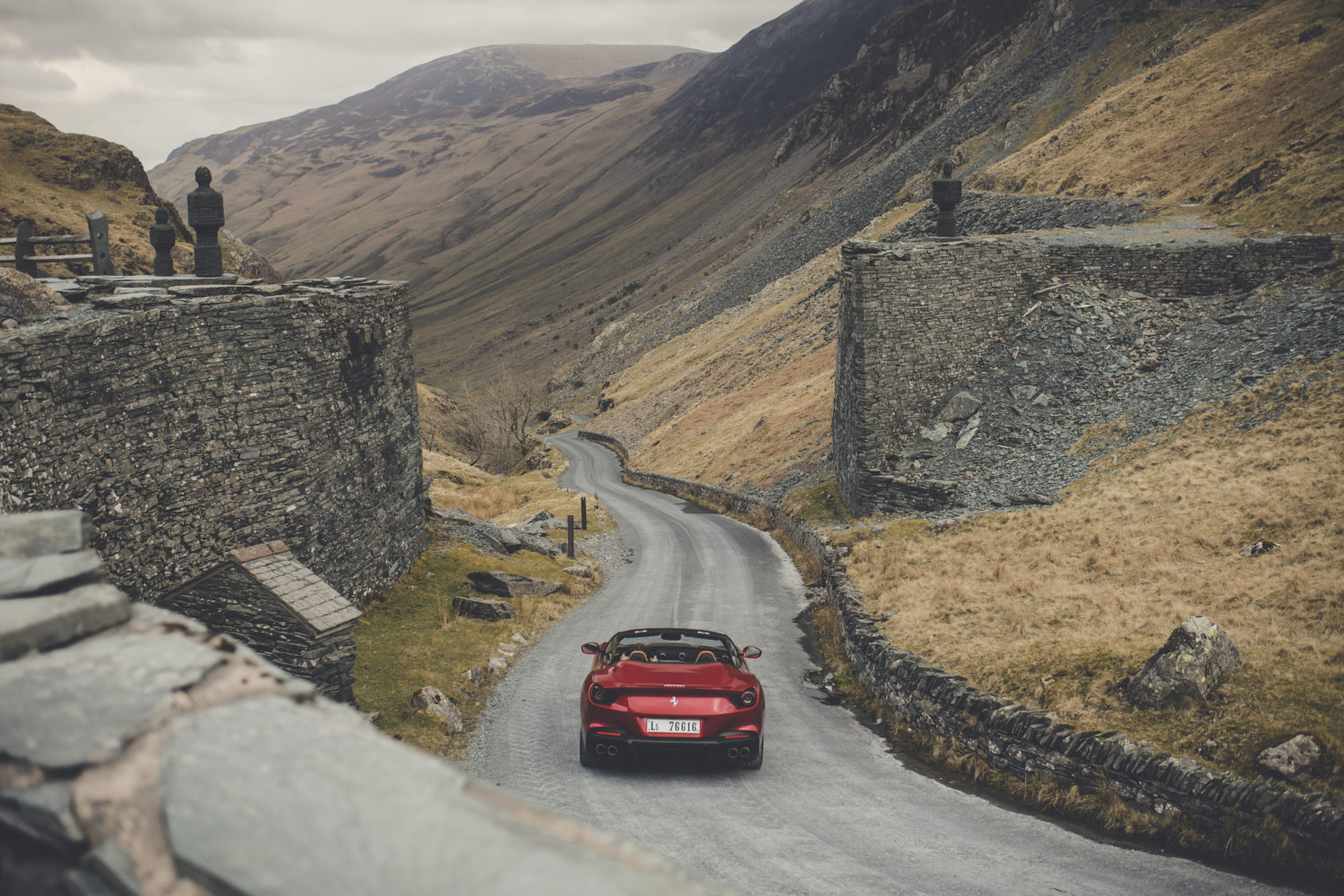
HONISTER PASS, LAKE DISTRICT
“I’m making time!” repeated Richard E Grant’s Withnail, and it’s true that there is something about the Lake District that makes you want to put your foot down. England’s most verdant national park, the Lake District is as much a mecca for motorists as it is for hikers and cyclists, provided you can get away from the bottlenecks of Lake Windermere.
The district’s finest uninterrupted driving is to be found on the Honister Pass, which is the section of the B5289 between Seatoller and Gatesgarth. Rising to 356m, it forms part of a scenic circuit. The Honister Pass is only 3.7 miles long, but if you start in Keswick and take the B5289 south past Derwent Water, follow the Honister Pass west and take the right hand turn north up the Newlands Pass to Braithwaite, then take the A66 east for a few minutes back to Keswick, you’ll have racked up 23 miles of smiles.
The Pass skirts the Honister Slate Mine, the last working mine of its kind in England. It’s also a tourist
attraction, offering underground tours, climbing and abseiling.
After all that effort, you (or at least your passenger) will have earned a pint of homemade cask ale at the rustic Kirkstile Inn in Loweswater, a world away from the tourist rabble. Located at the foot of the Mellbreak hill, it also offers newly refurbished rooms and first rate pies.
Something the Lake District is not short of is fine dining. There are more Michelin-starred restaurants here per capita than London, Paris and Tokyo combined, as evidenced in Steve Coogan and Rob Brydon’s comi-travel series The Trip. Top of the list is L’Enclume.
Located at the bottom of the national park, A-list chef Simon Rogen’s restaurant is a two-star masterpiece. In the interests of brevity we shan’t list the full 17-course tasting menu, but highlights include a beef dumpling in broth so flavoursome it’ll cause involuntary spasms, and veal so tender you could cut it by blowing on it. In short, it lives up to the hype.
Holding a star itself, Grasmere’s Forest Side offers contemporary luxury accommodation within the confines of a Victorian manor and, delighting its epicurean guests, Head Chef Paul Leonard uses his foraging skills to produce an innovative menu inspired by the Cumbrian landscape. The ingredients all come from the garden and nearby fields, lakes and sea; pig’s tail, venison pastrami, langoustine, cod, oyster, rare-breed pork – each course more succulent than the next.
Other sites of interest may include the literary; such as the poet William Wordsworth’s grave at Grasmere, Victorian art critic John Ruskin’s house on Coniston Water, and The World of Beatrix Potter at Bowness-on-Windermere.
You may also wish to pay your respects to the region’s most famous speed demon. Donald Campbell
CBE set the world water speed record on Ullswater in 1955 at an average speed of 202.32mph. He
would die in 1967 at Coniston Water, aged 45, trying to go faster still, and is now buried in the churchyard. Campbell’s headstone is easy to spot; there’s a bluebird on it.
Further information:
thelakedistrict.org, honister.com, kirkstile.com, lenclume.co.uk, theforestside.com, hop-skip-jump.com.
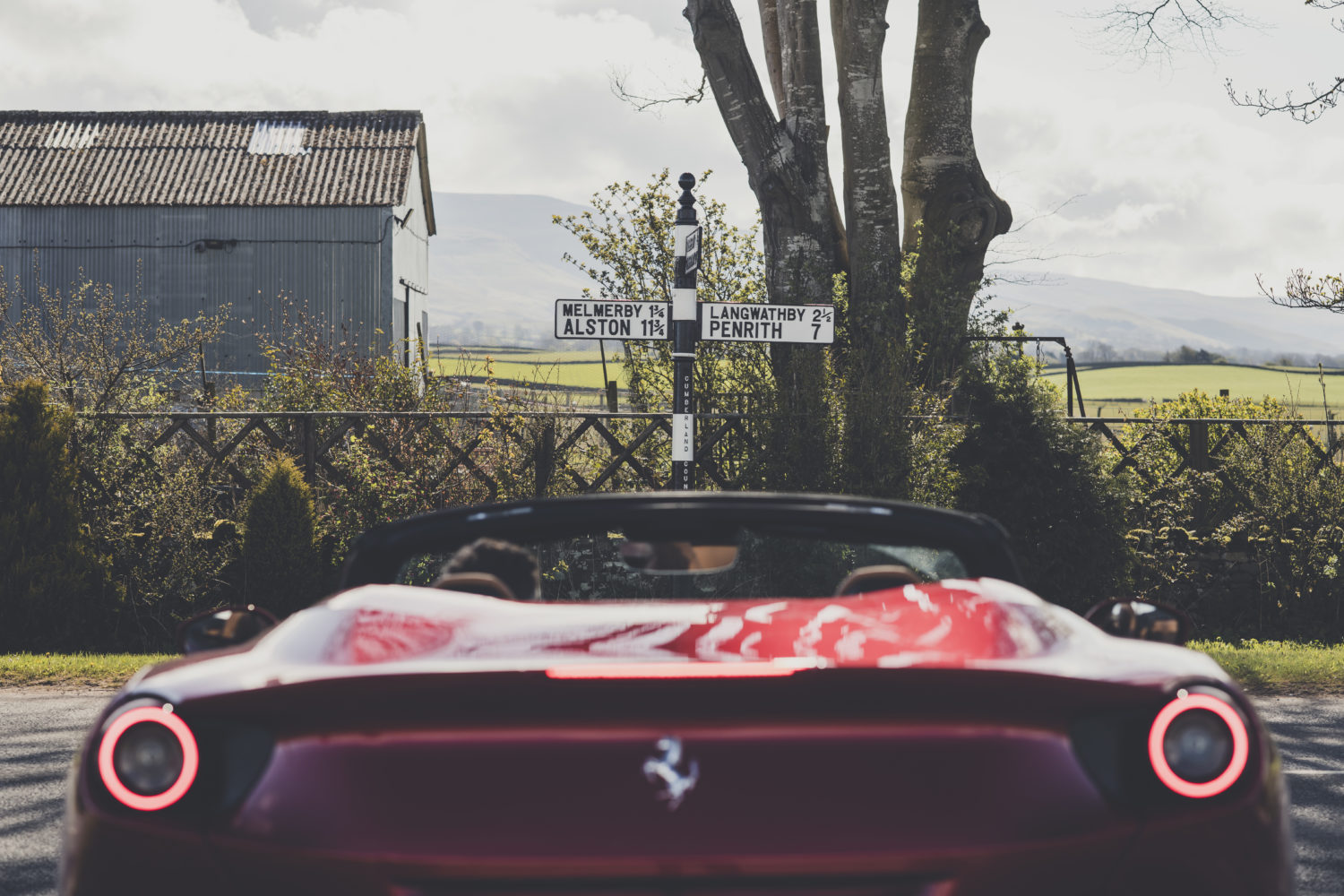
A686, CUMBRIA AND NORTHUMBERLAND
The Pennines never disappoint, and the A686 is a particularly majestic marriage of geography and engineering, full of zig-zagging and gear-changing joy throughout. You will insist on manual-mode here.
The beguiling 37 miles that connect Penrith, Cumbria, with the village of Haydon Bridge in Northumberland ranks as one of the north of England’s top three bits of blacktop. Crossing the River Eden, the road starts climbing and the landscape begins to brown from Melmerby to 580m above sea level at the Hartside summit, providing views across the Solway Firth and to Scotland. In the winter months the road is often snowed over. The well-sighted road leads to Alston, a charming village with quaint cobbled streets which claims to be England’s highest market town (they’re locked in a bragging battle with Buxton). The A686 beyond Alston cruises through another astonishing panorama of windswept upland before blasting down to the River Allen’s wooded gorge and throwing in some more stellar switchbacks for good measure.
There are a handful of cafes and food pubs along the route, including the Shepherds Inn at Langwathby Bridge, which does rooms and a generous trade in fish n’ chips, the Cumbrian Pantry and Blueberry’s Tea Shop, both in Alston, and the Elks Head at Whitfield, which also has accommodation. At the finish in Haydon Bridge you’ll find the Anchor hotel, overlooking the Tyne, where salmon jump over the weir. The hotel, which dates from 1422, operated as a court house during the Jacobite revolutions and hanged those judged to be guilty in what’s now the car park and beer garden.
Northumberland’s most acclaimed hotel of the moment is the Lord Crewe Arms, 20 miles south east of Haydon Bridge, in the honey-hued village of Blanchland. Its beauty has drawn poets including WH Auden and Philip Larkin. The fabric of the building dates back to a 12th century priory. Blanchland Abbey was lauded for its hospitality for 400 years until its dissolution in 1539. It passed through different private ownerships and from the 1720s, as the Lord Crewe Arms, served pints to miners after their shift. The pub part is now housed in the vaulted crypt. Food is worshipped upstairs, either in the Bishop’s dining room or beside a fireplace big enough to toast the toes of his entire flock. It’s so large that Tory politician, landowner and rebel ‘General’ Tom Foster hid inside it during the 1715 Jacobite
rising, and the hotel is said to be haunted by his sister, Dorothy. The dining room’s menu is seasonal, local and robust, brimming with flavours, and they’ll butcher your own birds upon request. Plenty of room in the Portofino M’s boot for a brace, and more than enough firepower up front.
Further information:
visitcumbria.com, visitnorthumberland.com, shepherds-inn.co.uk, anchorhotelhaydonbridge.com, lordcrewearmsblanchland.co.uk
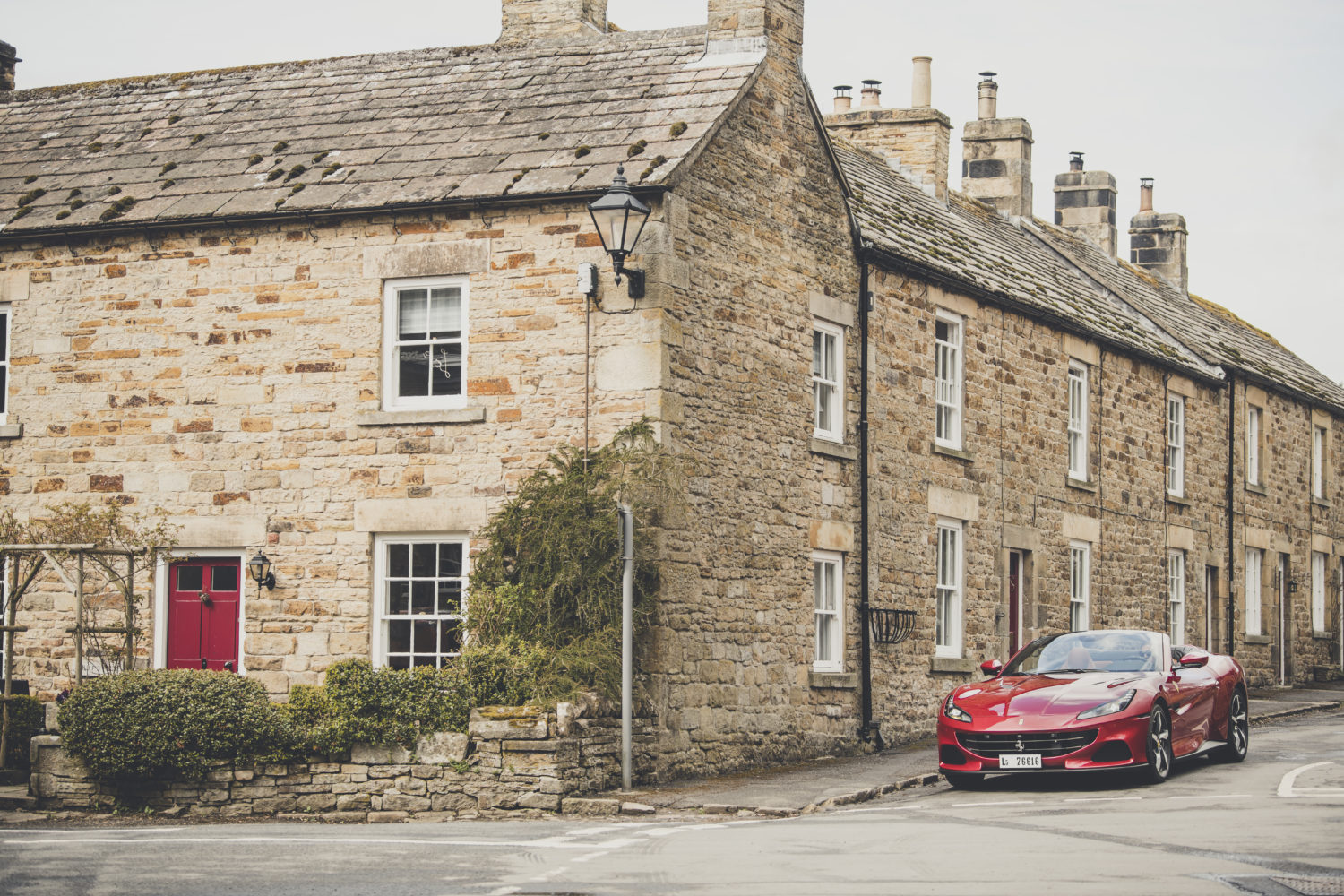
WALES
THE EVO TRIANGLE, SNOWDONIA
Spectacular Snowdonia is Wales’ largest national park and one of the outdoor adventure capitals of these isles. Along with Mount Snowdon and hundreds of hiking trails, it features 50+ lakes, Roman ruins, white water rapids and narrow-gauge railways.
Located in the rolling heart of the Denbigh Moors, the triangle formed between the A5, which runs to the south, A543 to the west and B4501 to the east has earned its nickname thanks to the never-ending number of EVO Magazine (and other) photoshoots that have taken place here since 1998. Car publications have helped make it a mecca for enthusiastic motorists.
The preferred route is to come off the A5 in the direction of Pentrefolas and head north east along the A543’s tight, sweeping bends. This is the wiggliest section, so you mightn’t fully appreciate the gorgeous expanses seen from the side windows. The road climbs steeply and is framed by unforgiving granite walls, overhanging canopies and vast, bleak moorland. After passing the Sportsman’s Arms on the left, take the right turn onto the B4501. This is the tip of the triangle. One is afforded a view of the Llyn Brenig Lake. The road leads back to the A5, passing through the village of Cerrigydrudion and bringing you full circle. In total, the route is 20 miles long.
The Dragonfly Tearoom on the A5 at Pant Dedwydd is a good place for a caffeine fix before you hit the route, and for a nerve-soothing cuppa after. Or head to the Ponderosa Café at the top of the Horseshoe Pass near Llangollen to the east, for Snowdonia’s magnificent roads are not merely restricted to the EVO Triangle. Everywhere you look is an opportunity to take an epic photo or get the tail end out. For the Horseshoe Pass, take the A542 between the A5 and the A5104.
For lodgings, we recommend Portmeirion (see chapter ‘Anglo-Italiano’ for more details). Closer to the action, though, is the Bryn Tyrch Inn situated on the A5. This country-chic roadside auberge is characterful and cosy, and offers upmarket pub grub and a beer garden with Mount Snowdon as its
vista. Another hotel popular with car reviewers is The Royal Oak in Betws-y-Coed, a smart former coaching inn overlooking the Llugwy River.
At the five-star end, the gastronomy and accommodation at Palé Hall is sublime. This indulgent Relais & Chateaux destination on the eastern side of the national park is an imposing Victorian mansion set in idyllic woodland which has an acclaimed restaurant with a Michelin green star. Queen Victoria was among its previous guests, though no word on whether she set her own EVO Triangle laps in a pony and trap.
Further information:
visitsnowdonia.info, portmeirion.wales, bryntyrchinn.co.uk, royaloakhotel.net, palehall.co.uk.
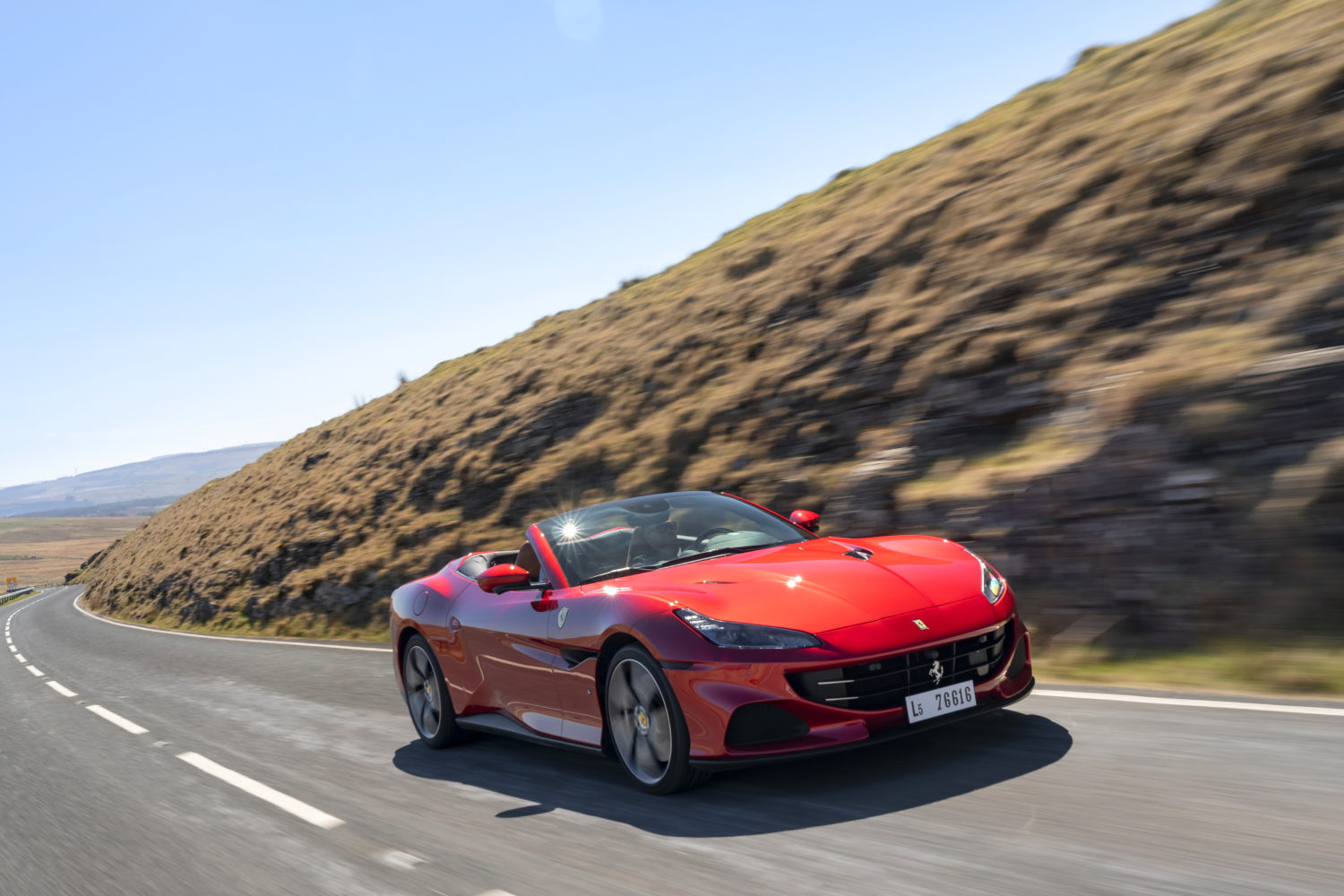
BLACK MOUNTAIN ROAD, BRECON BEACONS
So wild is the Brecon Beacons’ wilderness, that this is where the SAS train. The roads which criss-cross it are as majestic as the land itself. There’s the B4560, A470, A470, A4059, A4067, and best of all the A4069, aka Black Mountain Road.
Located in the western area of the national park, it’s famous for its twists, dips and climbs, and is known to many petrolheads as ‘the Top Gear road’. Stretching from Upper Brynamman up to Llangadog, it’s 20 miles long and reaches a height of 493m above sea level. From a driving perspective, the road is best tackled from north to south, especially the hairpin known as Tro Gwcw, or ‘Cuckoo Turn’, but the breathtaking views of the Tywi Valley are best appreciated going the other way, so you should turn around and come back the way you came.
The Black Mountain region culminates at the 802m summit of Fan Brycheiniog and features two pristine glacial lakes. There are also two castles to visit; the 12th century Carreg Cennen and Dinefwr ruins.
The area is home to several cultural shindigs, such as the Hay Literary Festival which is being held on the 26 May to 6 June this year, Brecon Jazz on 13-15 August, and the Green Man music festival on 19-22 August. The Brecons are also home to a large network of underground caves, and Sgwd yr Eira, one of the UK’s most beautiful waterfalls.
Located on the A465 in the small village of Llanfihangel Crucorney, the 12th century Skirrid Mountain Inn is said to be the most haunted pub in the country, having once been a rallying point for those revolting against the rule of Henry IV.
For Michelin-starred food, as well as rooms, head to The Walnut Tree in Llanddewi Skirrid. This has been the Brecons’ top gastro destination since the early 1960s, when it was owned and run by Franco Taruschio. Now chef Shaun Hill is in charge and his efforts have earned it best-restaurant-in-Wales accolades. The menu changes every day and draws strongly on Welsh beef and game, Scottish fish and French cheese.
More relaxed food, as well as drink and lodgings, can be found at The Felin Fach Griffin. It’s popular
with ramblers thanks to its location and relaxing sofas, crackling fires and cosy beamed bar.
Boasting a campanile, Gliffaes Country House Hotel is a little more formal, and its Italianate architecture
is on point if you’re hoping to replicate a bit of Tuscany on your Ferrari road trip.
Further information:
breconbeacons.org, walnuttreeinn.com, felinfachgriffin.co.uk, gliffaeshotel.com.
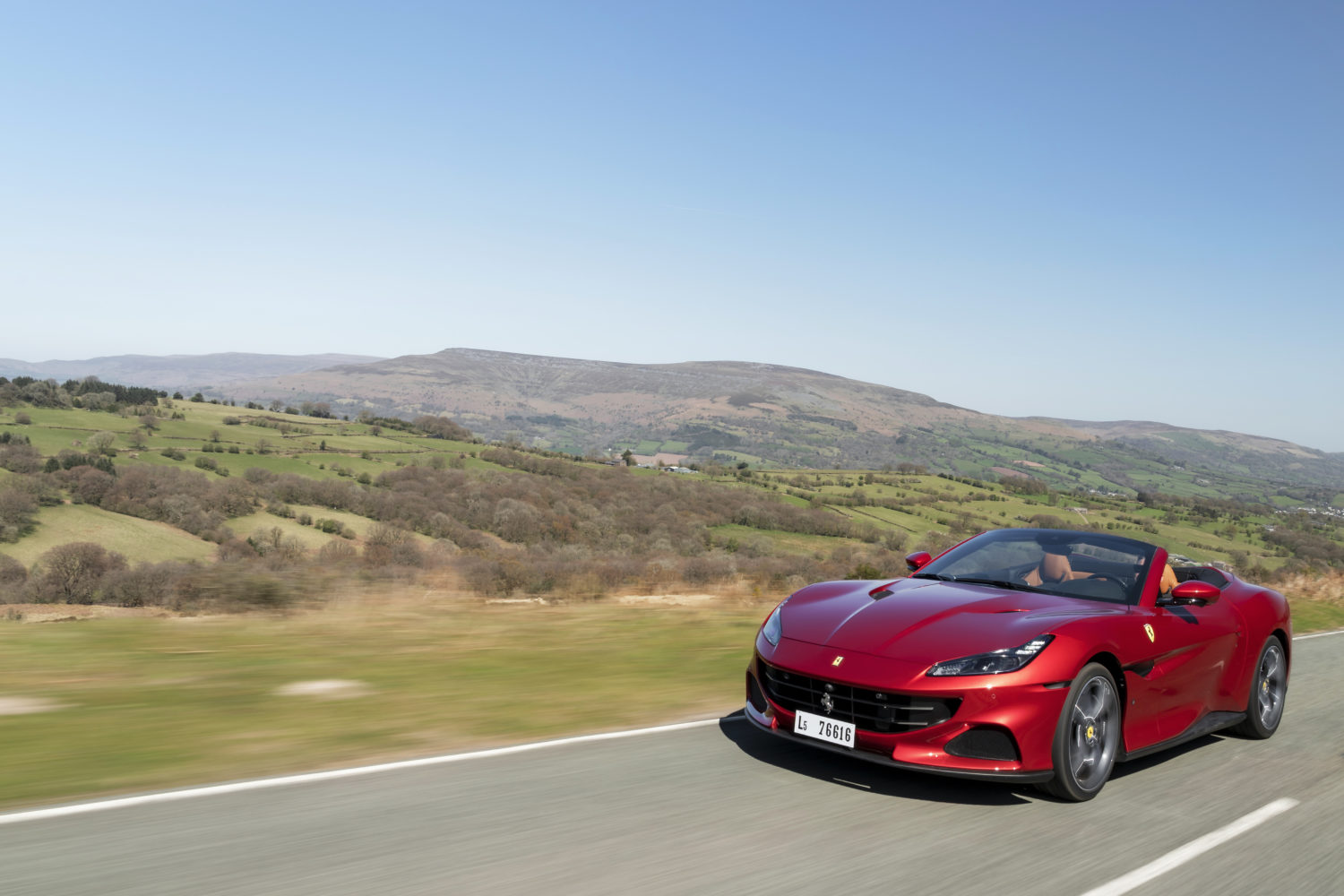
SCOTLAND
NORTH COAST 500
There are many roads around the world capable of vying for the title World’s Greatest. From the scenically spectacular – Australia’s Great Ocean Road, say, or California’s Pacific Coast Highway; and the exciting – Italy’s Stelvio Pass and Mount Fuji’s Touge roads; through to the dangerous – Bolivia’s Yungas Road or, for that matter, Germany’s killer Nürburgring. But we’ll wager that the most joyfully sublime route of them all is right here in the UK: Scotland’s northernmost coastal and highland roads.
It’s become known as the North Coast 500. Some call it Scotland’s Route 66; a 516-mile loop from Inverness to the tip of the isle and circumnavigating back. It’s popular in Summer with supercars, caravans, bikers and cyclists, each tackling it at their own pace but pausing regularly to absorb the cracking views.
We suggest starting with lunch in Inverness at Albert Roux’s restaurant at the Rocpool Reserve Hotel, overlooking the River Ness. With Chez Roux’s signature lemon tart and a double espresso in your belly, you’ll be ready for an epic road trip.
Drive the route anticlockwise and you’ll find the scenery just gets more and more spectacular. Take the A9 out of Inverness, cross the Black Isle, named after its dark farming soil, and pass the Dalmore whisky distillery to make your way up the east coast. Oil rigs in the Cromarty Firth can be made out
through the side window, camouflaged between the battleship grey sea and sky. Peel off momentarily at Balintore to visit the Mermaid of the North, sitting 10ft high on a rock and carefully positioned so that locals can check the tide as her tail becomes fully submerged.
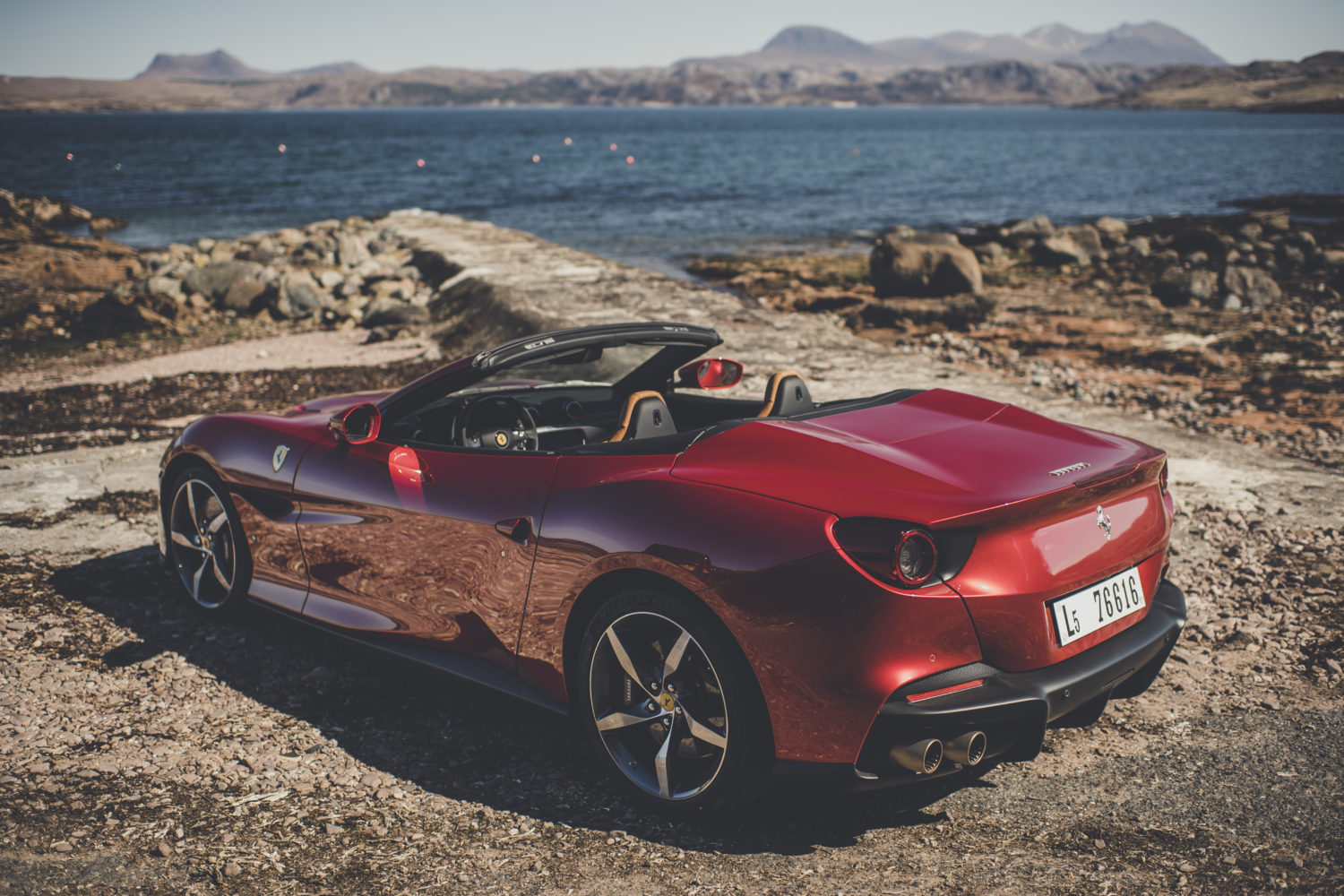
Pass the turreted Dunrobin Castle and continue along the A9 until Dunbeath. Take the A99 and keep an eye out for dolphins. At Wick, you may wish to visit the five-storey 15th century Ackergill Tower. Transporting you back in time, this castle (which has lately been used as a filming location for The Crown) is stocked with interesting antiques and furniture, taxidermy and tartan, and boasts an enchanting vista of coal-black rock stacks and crashing waves. Elsewhere on the 3,000 private acres you’ll find Europe’s largest and most luxurious tree house. Until recently, the property was a five-star hotel beloved of car manufacturers, but has now passed into private (American) hands. Nevertheless, you’ll be amazed by the kind of access a Portofino M affords.
A short drive from Ackergill is John O’Groats where a signpost points to Land’s End, 876 miles to the south west. The A99 becomes the A836. A few miles later, you may choose to stop at the Castle of Mey, where the Queen Mother headed when she needed to get away from it all. Alternatively, rent a board at Dunnet Bay, a surfer’s paradise. Thurso is Scotland’s most northerly town and its granite-fronted high street will be the last proper hub you’ll see till returning to Inverness.
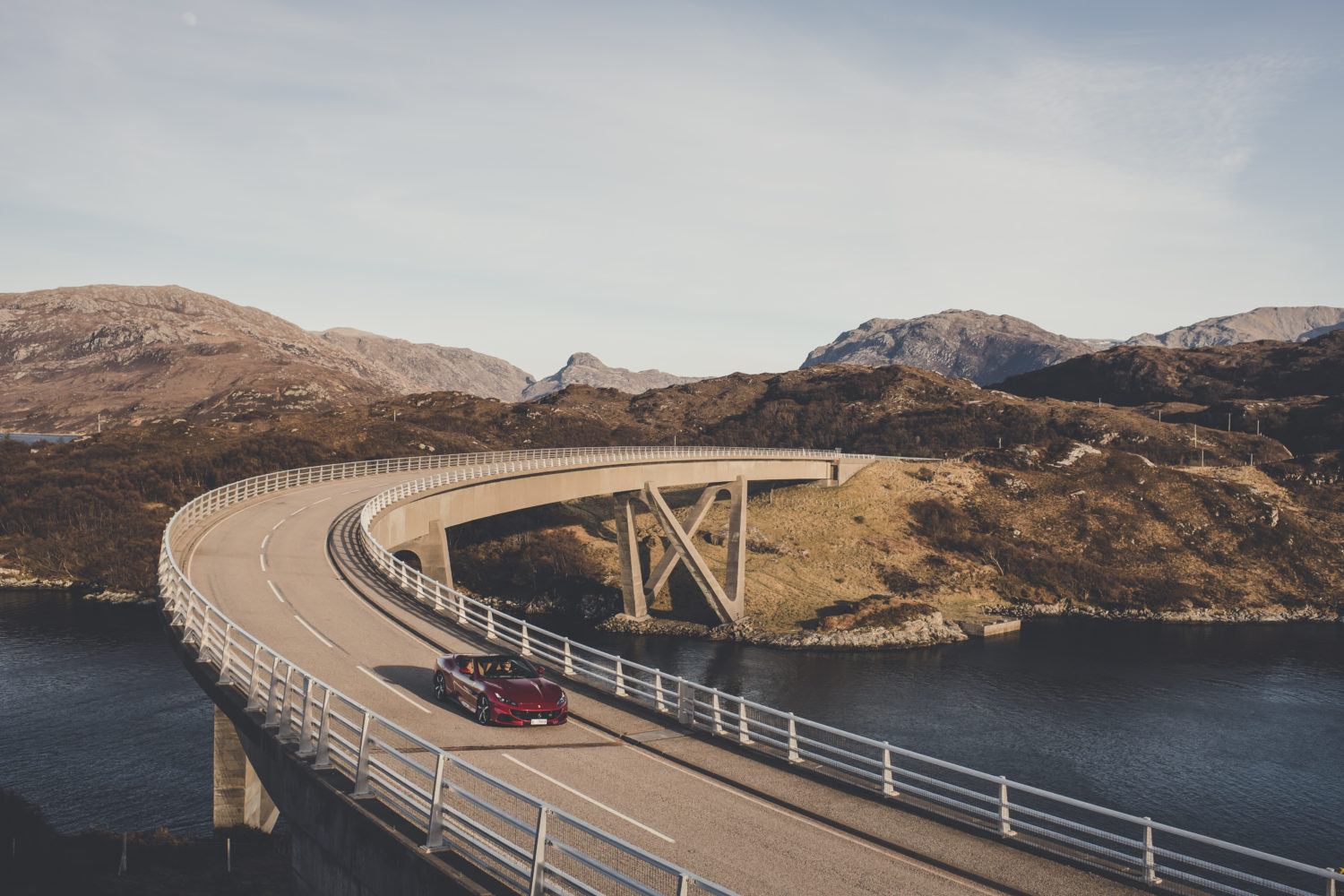
Swap the A836 for the A838 at Tongue. Having skirted glistening lochs and caramel beaches, you’ll head south at Durness and into ever more wondrous landscape. The mountains of Foinaven, Arkle and Quinag are almost within touching distance, but separated by boggy and rocky moor. At Laxford Bridge, swap the A838 for the A894. Stop at the 16th Century ruins of Ardvreck Castle and accost Highland cattle. Switching suede Italian driving shoes for wellies will feel like something of a metaphor.
You may wish to spend the night in the small fishing port of Lochinver, on the A387. Shaped like a policeman’s helmet, Suilven rises 731m above the town and is one of the most distinctive mountains in the country. Perched on an opposing hill, The Albannach is a cozy boutique hotel with just five bedrooms but plentiful snugs, and benefits from Britain’s northernmost Michelin-starred restaurant.
There’s still 234 miles to go. The scenery, unbelievably, continues to improve. Take the A835 south, stop at the Rhue gallery in Ullapool to view landscape paintings by local artists, and then take the A832. Through South West Sutherland, you will pass the dramatic peaks of Canisp, Cul Mor and Ben More Assynt. This Geopark consists of some of the most ancient and unique geology on the planet, dating back three billion years. Park at Gruinard Bay, and admire its rocky coves and unusual pink sand leading out to island-studded waters.
Past Gairloch, you’ll skim the ancient volcanic peaks of Assynt and drive through Caledonian pine forests. Take a right after Gairloch and the village of Kerrysdale to visit the independent Badachro tiny- batch whisky, gin and vodka distillery. A little further south, off the A896, is The Torridon. A Victorian shooting lodge turned five-star hotel, set in 58 acres of parkland, its Scots pine-panelled dining room serves acclaimed food straight from the local land and loch.
Sixteen miles south along the same road is the Kishorn Seafood Bar, a sky-blue log cabin at the head of Lock Hishorn, with spectacular views of the Cuillin Hills and Applecross peninsula. Fresh and simply- served, it’s renowned for its hand-dived scallops, oysters, plump mussels, langoustines and squat lobsters.
The twistiest part of the journey is the Bealach na Ba mountain pass. The views across to the Isle of Skye here are incredible and it feels like you’re on the edge of the world. At Applecross, look out for bobbing seals.
Careful of the fog that often descends on Beinn Bhan mountain, for the drops are sheer. Once back on the A832 you’ll be able to put the hammer down and the threescore of these final 516-miles will flicker in the rear-view mirror.
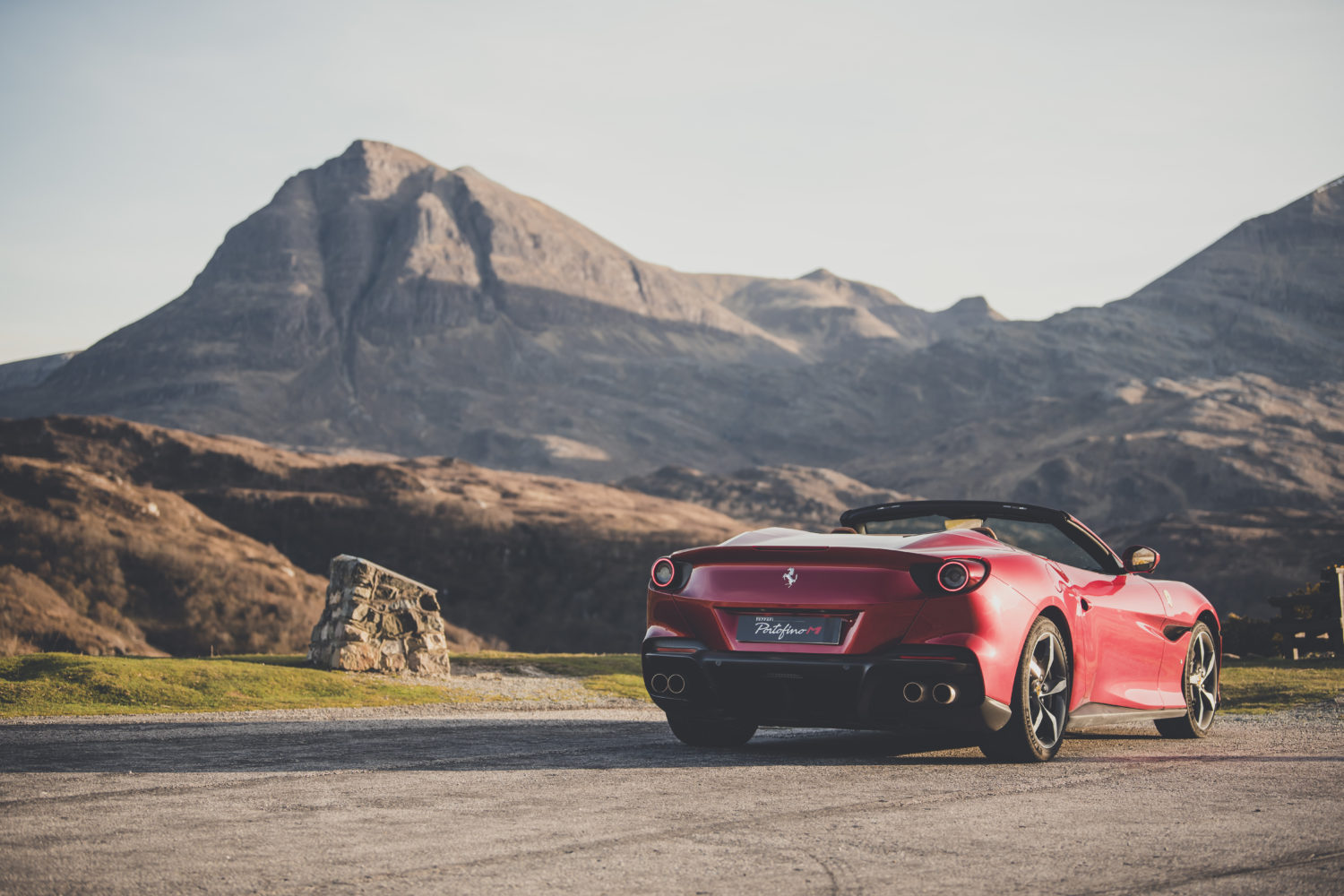
Further information:
northcoast500.com, rocpool.com, thedalmore.com, thealbannach.co.uk, rhueart.co.uk, badachrodistillery.com, thetorridon.com, kishornseafoodbar.co.uk.
OLD MILITARY ROAD, THE CAIRNGORMS
The Cairngorms is the UK’s largest national park and home to four of its five tallest mountains. Through it blasts the Old Military Road, which should be savoured like the finest single malt.
This 80-mile stretch of road, which cuts through the ski station at Glenshee, is accessed by heading north towards Perth and then picking up the A93 towards Blairgowrie. The landscape begins to rise after the Bridge of Cally where this fast-flowing A-road becomes something of a rollercoaster. The most spectacular stretch is the Cairnwell Pass which, at 670m, is the highest public road in Britain. The Cairnwell chairlift at Glenshee Ski Centre runs throughout the summer, till the end of September, if you want to top the views you’ve already been enjoying from the car. Skiing itself starts from 19 December.
Follow Shee Water down through its long valley to Braemar, home of the Royal Highland Games. Nine miles beyond Braemar you’ll skirt Her Majesty’s summer home, Balmoral Castle, back into the wilderness. Here, take the narrow B976 that climbs up over the moor. At Rinloan / Gairnshiel Lodge, the road splits in two. Take the left, the A939 baring north, which still counts as the Old Military Road. The road widens after a while, giving you a little more room to breathe. There are some steep and
thrilling hairpins to be lapped up towards the second ski station of the trip, at Lecht, followed by a sensational plunge down the other side of the mountain. The road is engaging to the last and finally spits you out at Granton-on-Spey. The whole thing should take just over two hours driving, plus stops.
The most stylish lodgings along the route are to be found at Braemar’s Fife Arms. Owned by the international art dealers Hauser & Wirth and decorated like a stage set, it’s packed full of stunning big- name works, from a Picasso portrait to Richard Jackson’s neon, glass and antler chandelier. A Louise Bourgeois spider stands on the inner terrace. A tiny watercolour of a stag’s head in the foyer was painted by Queen Victoria, who originally used this place as her guesthouse while staying up the road. It’s artfully contrasting.
The Fife Arms’ Flying Stag public bar is jolly and noisy, serving the best beer-battered fish n’ chips in the Cairngorms. Elsa’s Bar, named after fashion designer Elsa Schiaperelli, is pink, art deco and tiny. The Clunie Dining Room is theatrical and provides arguably the finest brunch in Scotland. Head chef Marcus Sherry’s dinner highlights include locally foraged girolles and generous cuts of Aberdeen Angus.
Just to the south of Balmoral you’ll discover the Royal Lochnagar distillery, where they’ll welcome you with a wee dram or, if you prefer gin, hold on to the finish line at Granton-on-Spey to visit the Balmenach Distillery, home of artisanal small batch Caorunn Gin. Tours are twice daily, so do book ahead. It would be a fitting end to a spirited drive.
Further information:
visitcairngorms.com, ski-glenshee.co.uk, thefifearms.com, caorunngin.com.
A82 FROM DUMBARTON TO GLENCOE
Driving a Ferrari on the A82 towards Glencoe, it’s useful to know that Italy’s version of MI6 is called AISE (Agenzia Informazioni e Sicurezza Esterna), because this is the road that James Bond calls home. Which nation’s secret agents have the better company cars is open to debate.
The A82 starts north west of Glasgow, drives past Dumbarton, and then burrows its way along beautiful Loch Lomond and The Trossachs national park and onto Loch Tulla and the high plateau of Rannoch Moor. Ruler-straight sections give way to an asphalt helter-skelter ride. The vast, peaty moor is positively Tolkien, and narrows towards the Toblerone peak of Buachaille Etive Mor; a lone pyramid guarding the entrance to the valley. Take the unnamed left before the mountain, running along the River Etive, in search of a 007 photo op.
Glen Etive is one of the most stunning spots in all of Scotland, once only visited by kayakers, but since it served as a layby for Daniel Craig and Judy Dench in Skyfall you’ll find a number of Bond aficionados trying to recreate their own DB5 moment.
Back on the A82 and approaching Glen Coe itself, the road wiggles its way through black volcanic rocks, steep cliffs and foamy waterfalls. Stop and admire the giant shoulders of the Three Sisters mountain range, and tip the piper in full Highland dress who’s there every day of the tourist season.
From here the road rolls downhill and in ten minutes or so spills into Glencoe Village. You may wish to stop at the Clachaig Inn before you reach the finish line for some venison carpaccio and game pie. This pub and hotel dates back to the 16th century. A sign on the door reads ‘No hawkers or Campbells’ in wry reference to the Massacre of Glencoe of 1692.
Other comfortable lodgings directly along the route are to be found just before Loch Tulla at the Bridge of Orchy Hotel, or The Inn on Loch Lomond. Both are four-star coaching inns with refurbished rooms and hearty food. They’ve each been welcoming travellers for 150 years, and most of the prancing horses that have visited have required tying up.
Further information:
lochlomond-trossachs.org, clachaig.com, bridgeoforchy.co.uk, innonlochlomond.co.uk.
NORTHERN IRELAND
CAUSEWAY COASTAL ROUTE
Skirting the Irish Sea and rugged North Atlantic coast, the Causeway Coastal Route is a scenic drive taking the A2, B15 and A2 again in an arc between Belfast and Londonderry. The journey through County Antrim includes bracing beaches, craggy cliffs, biscuit tin villages, fishing hamlets, sweeping bays and ancient fortresses. Such is its raw, elemental beauty that Lonely Planet has voted it the No.1 region in the world to visit.
Taking the A2 north out of Belfast, with the sea to your right, one passes Carrickfergus Castle, one of
Ireland’s best preserved Medieval buildings.
In Carnlough, just over an hour into the drive, is the Londonderry Arms Hotel. It was built in 1848 as a coaching house for the Marchioness of Londonderry, and was later owned by Winston Churchill. Quirky rooms are available, decorated tastefully with antique furniture, including the one Sir Winston slept in.
The scenery between Cushenden and Ballintoy Harbour may be familiar to fans of Game of Thrones, the latter – located alongside the B15 – doubling as the Iron Islands. Settlers here have been traced back 9,000 years. You may wish to take the A44 south at Ballycastle to visit The Dark Hedges, an atmospheric avenue of twisted beech trees that was filmed for GoT.
Keep driving west along the coast and you’ll come to the Giants Causeway, a UNESCO World Heritage site comprising 40,000 interlocking basalt columns. Legend has it this was built by mythological giant warrior Finn MacCool to get halfway to Scotland and challenge a Scottish giant to some fisticuffs. Further along the A2 is Bushmills, home to the Old Bushmills Whiskey Distillery, and the ruins of Dunluce Castle, perched dramatically on the cliffs, which inspired CS Lewis’ Narnia.
For brunch and dining, The French Rooms in Bushmills is a nod to the region’s Huguenot settlers, who were greatly involved in the Ulster linen industry. It serves Gallic classics such as tarte flambée and roast suprême of guinea fowl. For grub more typical of the coast, the best fish n’ chips can be found at Morton’s in Ballycastle. Nobody’s cod and haddock comes fresher. Should you prefer to stick to the theme of the Portofino M, you may wish to eat at Amici in Portstewart, overlooking the ocean, which takes enormous pride in its charcoal oven pizzas.
Fascinating ruins and sheltered gardens are to be found in County Londonderry’s beautiful and mysterious Downhill Demesne, a National Trust property affording spectacular views of Mussenden Temple and the North Atlantic. The basalt cliffs at Binevenagh give a panorama from Lough Foyle to Donegal. Guarding the entrance to Lough Foyle is another beauty spot, the remote Magilligan Point nature reserve – a paradise for twitchers. This is the tip of one of the largest sand dune systems in the British Isles.
From here, it’s a 40-minute drive to Ireland’s only remaining walled city, Londonderry. Park the car and cross the River Foyle via the suspended Peace Bridge, a symbolic walk from Derry’s ‘waterside’ to the ‘cityside’.
Further information:
causewaycoastalroute.com, discovernorthernireland.com/gameofthrones, londonderryarmshotel.com, thefrenchrooms.com, amiciportstewart.squarespace.com.
REPUBLIC OF IRELAND
WILD ATLANTIC WAY
The west coast of Ireland should be included in every top five list of The Most Beautiful Places in the World. The Wild Atlantic Way is a 1,500 mile touring route that starts in the rugged mountains of
Donegal in the north, passes through buzzy Galway and ends at the unspoilt southern beaches of Cork, with stunning Atlantic views to the starboard side for much of the way. And along the route, you’ll find incredible seafood and unforgettable pubs. Lots of them. Take your time with this one.
From Donegal, drive south along the N15. As you head towards Sligo you’ll also pass Ben Bulben, Ireland’s answer to Cape Town’s Table Mountain and, just beyond Sligo, Carrowmore which is home to 60 megalithic tombs. From Sligo, take the N4 followed by the N59 and drive west towards Aughris Head, where the fabulous thatched Beach Bar awaits. At Ballina, take the R314 north. One of the most impressive stretches of the Wild Atlantic Way is Dún Briste, a 50m high sea stack upon which the waves smash.
The next section of the Wild Atlantic Way brings you through pirate country. Carraigahowley Castle was home to ‘The Pirate Queen’, Grace O’Malley. Achill Island is accessible by bridge and its Atlantic Drive, to the south, has some of the best sea views of the entire route. Continuing the journey from Achill to Westport on the N59 you pass along Clew Bay which, they say, is home to 365 islands – one for every day of the year. No wonder it was a pirate mecca.
At Westport, take the R335 until it meets with your old friend the N59 again. Along the way you may wish to stop to climb Croagh Patrick mountain. Thousands of pilgrims visit the 760m mountain on the last Sunday of July each year. Its history as a place of worship pre-dates Christianity to 3,000BC. Patron saint Patrick is said to have fasted for 40 days here and, according to legend, banished snakes from Ireland from this very spot.
Extend your route at Clifden, the capital of Connemara, by peeling off the N59 and taking the Sky Road, which loops around the peninsula and affords incredible views of Clifden Bay. Once back in Clifden, take the R341 and visit Aillebrack Beach, Dog’s Bay and Gorteen Bay for beautiful, unspoilt beaches. Stop in Roundstone for a drink and some seafood at O’Dowd’s, overlooking the idyllic harbour.
The spectacular beaches continue off the R336 towards Galway, including Coral Beach and Silverstrand Beach, geological wonders with marvellous views of the Aran Islands.
Galway is the only city you’ll encounter before Cork, and it’s a lively place. Steel yourself for some of the northern hemisphere’s best bars. Whiskey drinkers go to Garavan’s or Sonny Molloy’s, as both have incredible rye menus. For traditional Irish music, head to Crane Bar, and for a quiet pint the locals recommend the Bunch of Grapes and Lonergan’s (no websites).
The world’s most famous milliner, Philip Treacy, is a native of Galway and has turned hotel designer with his five-star property The G. The décor is not to everyone’s taste, but they’re won over by the comfortable rooms and excellent cuisine. Less divisive is the beguiling Glenlo Abbey Hotel, an 18th century country house just outside the city. Its Pullman dining room is comprised of two antique railway carriages, once stars of Murder on the Orient Express, now repurposed as a plush restaurant.
There are many other food options, though, and if you’re willing to splash out then try the Michelin- starred Aniar, centred around Galway’s terroir and boasting a ten-course tasting menu.
Beyond the city, take the N67 and the R477 and savour the karst lunar-looking landscape. The hills of The Burren are composed of limestone pavements. Unique flora thrives here, as well as arctic and alpine plants.
The Cliffs of Moher in Liscannor, County Clare, are Ireland’s most visited natural attraction. Reaching
over 200m high, they were formed some 300 million years ago.
Rejoin the N67 at Lahinch and head to Kilkee in the heart of West Clare. The Loop Head Drive takes you within metres of the cliffs, and the rock formations are up to 80m high, bracing themselves against the turbulent tides. Keep an eye out for dolphins as you cross the Shannon Estuary and take the R551 to Tralee. This town is famous for its annual and televised Rose of Tralee beauty contest, held each August, which is – shall we say – more Father Ted than Hawaiian Tropic pageant.
From Tralee you begin what is perhaps the most magical section of the whole Wild Atlantic Way, especially the sections known as Connor Pass (Ireland’s highest mountain pass) and Slea Head Drive. The Dingle Peninsula is an at-times narrow route along cliff-face roads beyond the N86. Pull off at Camp and take the R560, then loop around the R559 and enjoy the views of the Blasket Sound – perhaps take the boat from Dunquin to visit the abandoned village on Great Blasket Island.
The little town of Dingle is a must-do for fans of Irish pub culture. The population is only 2,000 yet there are 50 inns here, and they all try to outdo each other on the quality of their Guinness. We particularly rate Foxy John’s, which doubles as a hardware store in the daytime, and Adams Bar which moonlights as a cobbler’s. If stout’s not your thing, visit the Dingle Distillery and try the local whiskey, gin and vodka.
After an evening of lively Irish entertainment you’ll be abandoning your Portofino M and staying the night. With their high thread count, Castlewood House and the Dingle Bay Hotel both provide a soft landing.
Take the N86 out of Dingle followed by the R561 and the N70 south from Castlemaine. This road, which loops around the Iveragh Peninsula to Kenmare, is called the Ring of Kerry.
The 10,000-hectare Killarney National Park features the highest mountain range in the country, the Macgillicuddy Reeks. Another Kerry highlight is Skellig Michael, a UNESCO World Heritage Site seven miles off the Iveragh Peninsula. Rising dramatically from the ocean, the island is home to a monastery that has existed in beautiful isolation for 1,300 years. Accessible by boat from Portmagee, Skellig Michael serves as a spectacular filming location for Star Wars: The Force Awakens and The Last Jedi.
Next is the Ring of Beara, which is less touristy than the Ring of Kerry and takes the R572 from Kenmare, followed by the R575 and R572 to Glengarriff, where one joins the N71. While touring the Beara Peninsula, visit the ancient stone circle at Ardgroom, and stop in Allihies to visit the two strikingly
decorated pubs next door to each other in the town (O’Neill’s and The Lighthouse Bar), or the equally
colourful village of Eyeries.
The final stretch is the Mizen Peninsula along the south west tip of the country, taking the R591, R592 and N71. Fastnet Rock is known as the ‘Teardrop of Ireland’ as it’s the last image of their homeland that emigrants would see on their sail to the New World. At 54m, it’s home to Ireland’s tallest lighthouse. The N71 leads east to Cork and the finish line of this fantastic journey. Have a Murphy’s at The Abbot’s Ale House (warning: do not ask for Guinness in Cork!), you’ve earned it.
Further information:
thewildatlanticway.com, thebeachbarsligo.com, odowdsseafoodbar.com, theghotel.ie, glenloabbeyhotel.ie, aniarestaurant.ie, dingledistillery.ie castlewooddingle.com, dinglebayhotel.com.
ANGLO -ITALIANO
Where can one experience Ferrari’s homeland without having to leave the British Isles? Allora…
PORTMEIRION:
Portmeirion, in North Wales, is a magical place. Behold, a Mediterranean vision emerging from the dark hills; a merry jumble of domes and turrets in ice-cream shades. Situated on the estuary of the River Dwyryd, it was the lifetime’s work of eccentric landowner and self-taught architect Sir Clough Williams-Ellis. Many of Portmeirion’s colourful cottages, grottos, tiny castles and towers look Italianate, making a Ferrari Portofino M feel at home. The Hotel Portmeiron offers 14 bedrooms, but you really ought to rent one of the stage set-like self-catering cottages. They promise, like the Ferrari, pure escapism.
CLIVEDEN:
Situated just 30 miles west of London, between the M4 and M40 motorways in Berkshire, Cliveden House is one of the most exclusive hotels in the country; a mating of Italian style and British taste. Crowning an outlying ridge of the Chiltern Hills and designed by Sir Charles Barry in 1851, it blends English Palladian architecture with the Italian Cinquecento, rendered in Roman cement. Your Ferrari will be perfectly on point here, its rakish glamour attuned to the house’s history of celebrity and scandal. The ‘Cliveden Set’ in the 1930s were the influencers of their day – thinkers, artists, moguls and
movie stars. Then, in July 1961, John Profumo met Christine Keeler beside the swimming pool and the British government was almost brought to its knees. More recently, Meghan Markle spent the night here before her wedding to Prince Harry. If she’d wanted to escape, a Portofino M would make a perfect getaway car. From here, there are wonderful roads that plough into the Chilterns, where you’ll find some of Britain’s best vineyards. Daws Hill, near Chinnor, makes a fabulous range of fruity and crisp fizz.
clivedenhouse.co.uk dawshillvineyard.co.uk
PORTHCURNO:
A stone’s throw from Land’s End, the Cornish village of Porthcurno is home to the Minack Theatre. Perched on ragged cliffs, this open-air amphitheatre is Roman in its inspiration and looks like it’s been there for 2,000 years. It conjured romance when it was used as a location in the 1944 film Love Story, with Margaret Lockwood and Stewart Granger. A Portofino M would be an excellent companion on a blast west along the A30, taking in Bodmin Moor and Jamaica Inn, once an epicentre of smuggling. For more luxurious lodgings, check into The Idle Rocks; a 20-room boutique hotel in the pretty little fishing village of St Mawes, which is situated across the Carrick Roads estuary from Falmouth. www.minack.com/minack-theatre
Italian restaurants in the UK are enjoying a renaissance, as chefs from the Mediterranean’s boot go back to their roots. Using traditional regional recipes with great British produce and imported delicacies, these five eateries promise the best Italian cooking outside London – or, indeed, Italy.
CALDESI IN CAMPAGNA, BRAY
Montepulciano-born Giancarlo Caldesi is committed to seasonality and sustainability, using Berkshire produce in his regional Italian dishes, which include Tuscan caciucco fish casserole, and slow-cooked beef cheek in red wine. Fine dining in a cosy setting by the Thames, and recommended by the Michelin Guide as well as this one.
caldesi.com/caldesi-in-campagna
AMANO, WEST MALLING, KENT
Using high-end Italian ingredients and Kentish farms, Roman Fabio Moschini cooks simple and robust recipes learnt from his grandmother. These include spaghetti carbonara made with guanciale, and chicken escalope with pea risotto. An added bonus is the Grade-II building’s four boutique guest bedrooms, meaning you can order that second bottle of vino.
CIN CIN, BRIGHTON
Cheers in Italian, Cin Cin has just 20 covers at a counter looking into an open kitchen and bar. Owner David Toscano’s family are from Calabria by way of Australia, and David serves updated Sicilian dishes such as tagliatelle with sardines, saffron and pickled sultanas, and fazzoletti served with grey mullet, purple sprouting broccoli and stracciatella cheese.
EUSEBI DELI, GLASGOW
What started as an Italian grocery store in Glasgow’s East End back in 1975 has shifted and expanded to the city’s West End, showcasing simple regional dishes and seasonal favourites. They bring tomatoes and herbs in from Calabria, flour from Rome and cured meats from Umbria. The pasta is made fresh on the premises.
MONO, EDINBURGH
Chic Mono adds modern Italian flair and experimental ingredients to simple traditional dishes, matching vivacious flavours with pristine contemporary presentation. It offers five and seven-course tasting menus, the latter including BBQ mackerel with fennel, orange and white vermouth, and grouse alla Milanese. The wine list is equally forward-thinking, championing lesser-known grapes and regions through independent and sustainable Italian producers.







